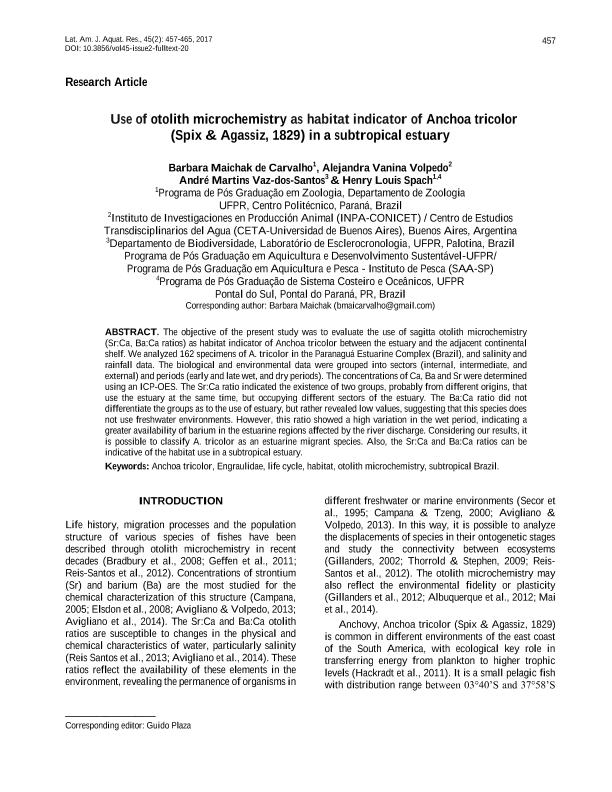Mostrar el registro sencillo del ítem
dc.contributor.author
de Carvalho, Barbara Maichak
dc.contributor.author
Volpedo, Alejandra

dc.contributor.author
Vaz dos Santos, André Martins
dc.contributor.author
Spach, Henry Louis
dc.date.available
2018-09-12T14:24:36Z
dc.date.issued
2017-12
dc.identifier.citation
de Carvalho, Barbara Maichak; Volpedo, Alejandra; Vaz dos Santos, André Martins; Spach, Henry Louis; Use of otolith microchemistry as habitat indicator of Anchoa tricolor (Spix & Agassiz, 1829) in a subtropical estuary; Pontificia Universidad Catolica de Valparaíso; Latin American Journal of Aquatic Research; 45; 2; 12-2017; 457-465
dc.identifier.issn
0718-560X
dc.identifier.uri
http://hdl.handle.net/11336/59267
dc.description.abstract
The objective of the present study was to evaluate the use of sagitta otolith microchemistry (Sr:Ca, Ba:Ca ratios) as habitat indicator of Anchoa tricolor between the estuary and the adjacent continental shelf. We analyzed 162 specimens of A. tricolor in the Paranaguá Estuarine Complex (Brazil), and salinity and rainfall data. The biological and environmental data were grouped into sectors (internal, intermediate, and external) and periods (early and late wet, and dry periods). The concentrations of Ca, Ba and Sr were determined using an ICP-OES. The Sr:Ca ratio indicated the existence of two groups, probably from different origins, that use the estuary at the same time, but occupying different sectors of the estuary. The Ba:Ca ratio did not differentiate the groups as to the use of estuary, but rather revealed low values, suggesting that this species does not use freshwater environments. However, this ratio showed a high variation in the wet period, indicating a greater availability of barium in the estuarine regions affected by the river discharge. Considering our results, it is possible to classify A. tricolor as an estuarine migrant species. Also, the Sr:Ca and Ba:Ca ratios can be indicative of the habitat use in a subtropical estuary.
dc.format
application/pdf
dc.language.iso
eng
dc.publisher
Pontificia Universidad Catolica de Valparaíso

dc.rights
info:eu-repo/semantics/openAccess
dc.rights.uri
https://creativecommons.org/licenses/by-nc-sa/2.5/ar/
dc.subject
Anchoa Tricolor
dc.subject
Engraulidae
dc.subject
Habitat
dc.subject
Life Cycle
dc.subject
Otolith Microchemistry
dc.subject
Subtropical Brazil
dc.subject.classification
Agricultura

dc.subject.classification
Agricultura, Silvicultura y Pesca

dc.subject.classification
CIENCIAS AGRÍCOLAS

dc.title
Use of otolith microchemistry as habitat indicator of Anchoa tricolor (Spix & Agassiz, 1829) in a subtropical estuary
dc.type
info:eu-repo/semantics/article
dc.type
info:ar-repo/semantics/artículo
dc.type
info:eu-repo/semantics/publishedVersion
dc.date.updated
2018-09-11T14:45:26Z
dc.journal.volume
45
dc.journal.number
2
dc.journal.pagination
457-465
dc.journal.pais
Chile

dc.journal.ciudad
Valparaíso
dc.description.fil
Fil: de Carvalho, Barbara Maichak. Universidade Federal do Paraná; Brasil
dc.description.fil
Fil: Volpedo, Alejandra. Consejo Nacional de Investigaciones Científicas y Técnicas. Oficina de Coordinación Administrativa Parque Centenario. Unidad Ejecutora de Investigaciones en Producción Animal. Universidad de Buenos Aires. Facultad de Ciencias Veterinarias. Unidad Ejecutora de Investigaciones en Producción Animal; Argentina
dc.description.fil
Fil: Vaz dos Santos, André Martins. Universidade Federal do Paraná; Brasil
dc.description.fil
Fil: Spach, Henry Louis. Universidade Federal do Paraná; Brasil
dc.journal.title
Latin American Journal of Aquatic Research

dc.relation.alternativeid
info:eu-repo/semantics/altIdentifier/doi/http://dx.doi.org/10.3856/vol45-issue2-fulltext-20
dc.relation.alternativeid
info:eu-repo/semantics/altIdentifier/url/http://www.lajar.cl/pdf/imar/v45n2/Art%C3%ADculo_45_2_20.pdf
Archivos asociados
